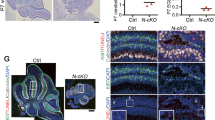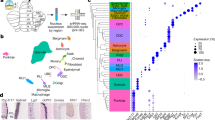Abstract
The cerebellum is essential for fine motor control of movement and posture, and its dysfunction disrupts balance and impairs control of speech, limb and eye movements. The developing cerebellum consists mainly of three types of neuronal cells: granule cells in the external germinal layer, Purkinje cells, and neurons of the deep nuclei1. The molecular mechanisms that underlie the specific determination and the differentiation of each of these neuronal subtypes are unknown. Math1 (refs 2, 3), the mouse homologue of the Drosophila gene atonal4, encodes a basic helix–loop–helix transcription factor that is specifically expressed in the precursors of the external germinal layer and their derivatives. Here we report that mice lacking Math1 fail to form granule cells and are born with a cerebellum that is devoid of an external germinal layer. To our knowledge, Math1 is the first gene to be shown to be required in vivo for the genesis of granule cells, and hence the predominant neuronal population in the cerebellum.
This is a preview of subscription content, access via your institution
Access options
Subscribe to this journal
Receive 51 print issues and online access
$199.00 per year
only $3.90 per issue
Buy this article
- Purchase on Springer Link
- Instant access to full article PDF
Prices may be subject to local taxes which are calculated during checkout





Similar content being viewed by others
References
Altman, J. & Bayer, S. A. in Development of the Cerebellar System: In Relation to its Evolution, Structure, and Functions (CRC Press, Boca Raton, Florida, (1996)).
Akazawa, C., Ishibashi, M., Shimizu, C., Nakanishi, S. & Kageyama, R. A. Mammalian helix–loop–helix factor structurally related to the product of Drosophila proneural gene atonal is a positive transcriptional regulator expressed in the developing nervous system. J. Biol. Chem. 270, 8730–8738 (1995).
Ben-Arie, N. et al. Evolutionary conservation of sequence and expression of the bHLH protein Atonal suggest a conserved role in neurogenesis. Hum. Mol. Genet. 5, 1207–1216 (1996).
Jarman, A. P., Grau, Y., Jan, L. Y. & Jan, Y. N. atonal is a proneural gene that directs chordotonal organ formation in the Drosophila peripheral nervous system. Cell 73, 1307–1321 (1993).
Hatten, M. E. & Heintz, N. Mechanisms of neural patterning and specification in the developing cerebellum. Annu. Rev. Neurosci. 18, 385–408 (1995).
Hallonet, M. E. & Le Dourain, N. M. Tracing neuroepithelial cells of the mesencephalic and metencephalic alar plates during cerebellar ontogeny in quail-chick chimaeras. Eur. J. Neursci. 5, 1145–1155 (1993).
Hatten, M. E., Alder, J., Zimmerman, K. & Heintz, N. Genes involved in cerebellar cell specification and differentiation. Curr. Opin. Neurobiol. 7, 40–47 (1997).
Jarman, A. P., Sun, Y., Jan, L. Y. & Jan, Y. N. Role of the proneural gene, atonal, in formation of Drosophila chordotonal organs and photoreceptors. Development 121, 2019–2030 (1995).
Yang, X. W., Zhong, R. & Heintz, N. Granule cell specification in the developing mouse brain as defined by expression of the zinc finger transcription factor RU49. Development 122, 555–566 (1996).
Debus, E., Weber, K. & Osborn, M. Monoclonal antibodies specific for glial fibrillary acidic (GFA) protein and for each of the neurofilament triplet polypeptides. Differentiation 25, 193–203 (1983).
Tohyama, T. et al. Nestin expression in embryonic human neuroepithelium and in human neuroepithelial tumor cells. Lab. Invest. 66, 303–313 (1992).
Smeyne, R. J. & Goldowitz, D. Development and death of external granular layer cells in the weaver mouse cerebellum: a quantitative study. J. Neurosci. 9, 1608–1620 (1989).
Wood, K. A., Dipasquale, B. & Youle, R. J. In situ labeling of granule cells for apoptosis associated DNA fragmentation reveals different mechanisms of cell loss in developing cerebellum. Neuron 11, 621–632 (1993).
His, W. Die Entwicklung des menschlichen Rautenhirns vom Ende des ersten bis zum Beginn des dritten Monats. I. Verlängertes Mark. Abhandlung der königlicher sächsischen Gesellschaft der Wissenschaften, mathematische-physikalische Klasse 29, 1–74 (1891).
Heintz, N., Norman, D., Gao, W.-O. & Hatten, M. in genome Maps and Neurological Disorders (eds Davies, K. E. &Tilghman, S. M.) 19–45 (Cold Spring Harbor Laboratory Press, New York, (1993)).
Mouse Genome Database 3.1 (Mouse Genome Informatics, The Jackson Laboratory, Bar Horbor, Maine(http://www.informatics.jax.org/), (1996)).
Frontiers in Bioscience 2.6 (http://www.bioscience.org/knockout/knochome.html) (1997).
Goffinet, A. M. Events governing organization of postmigratory neurons: studies on brain development in normal and reeler mice. Brain Res. Rev. 7, 261–296 (1984).
Rezai, Z. & Yoon, C. H. Abnormal rte of granule cell migration in the cerebellum of weaver mutant mice. Dev. Biol. 29, 17–26 (1972).
Joyner, A. L. Engrailed, Wnt and Pax genes regulate midbrain–hindbrain development. Trends Genet. 12, 15–20 (1996).
McMahon, A. P. & Bradley, A. The Wnt-1 (int-1) proto-oncogene is required for development of a large region of the mouse brain. Cell 62, 1073–1085 (1990).
Thomas, K. R. & Capecchi, M. R. Targeted disruption of the murine int-1 proto-oncogene resulting in severe abnormalities in midbrain and cerebellar development. Nature 346, 845–850 (1990).
Thomas, K. R., Musci, T. S., Neumann, P. E. & Capecchi, M. R. Swaying is a mutant allele of the proto-oncogene Wnt-1. Cell 67, 969–976 (1991).
McMahon, A. P., Joyner, A. L., Bradley, A. & McMahon, J. A. The midbrain–hindbrain phenotype of Wnt-1-/Wnt-1- mice results from stepwise deletion of engrailed-expressing cells by 9.5 days postcoitum. Cell 69, 581–595 (1992).
Millen, K. J., Wurst, W., Herrup, K. & Joyner, A. L. Abnormal embryonic cerebellar development and patterning of postnatal foliation in two mouse Engrailed-2 mutants. Development 120, 695–706 (1994).
Wurst, W., Auerbach, A. B. & Joyner, A. L. Multiple developmental defects in Engrailed-1 mutant mice: an early mid-hindbrain deletion and patterning defects in forelimbs and sternum. Development 120, 2065–2075 (1994).
Guillemot, F. et al. Mammalian achaete-scute homolog 1 is required for the early development of olfactory and autonomic neurons. Cell 75, 463–476 (1993).
Albrecht, U., Eichele, G., Helms, J. & Lu, H. in Visualization of Gene Expression Patterns byin situHybridization (ed. Daston, G. P.) 23–48 (CRC Press, Boca Raton, Florida, (1997)).
Schaeren-Wiemers, N. & Gerfin-Moser, A. Asingle protocol to detect transcripts of various types and expression levels in neural tissue and cultured cells: in situ hybridization using digoxigenin-labelled cRNA probes. Histochemistry 100, 431–440 (1993).
Acknowledgements
We thank B. A. Antalffy for technical assistance; P. R. Cox and J. Dong for their help; and R. R. Behringer, K. A. Mahon and B. Hassan for critical reading of the manuscript. H.Y.Z. is an investigator and H.J.B. is an associate investigator of the Howard Hughes Medical Institute. This work was supported by grants from the NIH/NINDS and by the Baylor Mental Retardation Research Center.
Author information
Authors and Affiliations
Corresponding author
Rights and permissions
About this article
Cite this article
Ben-Arie, N., Bellen, H., Armstrong, D. et al. Math1 is essential for genesis of cerebellar granule neurons. Nature 390, 169–172 (1997). https://doi.org/10.1038/36579
Received:
Accepted:
Issue Date:
DOI: https://doi.org/10.1038/36579
This article is cited by
-
Revisiting the development of cerebellar inhibitory interneurons in the light of single-cell genetic analyses
Histochemistry and Cell Biology (2024)
-
In focus in HCB
Histochemistry and Cell Biology (2024)
-
Identification and characterization of transcribed enhancers during cerebellar development through enhancer RNA analysis
BMC Genomics (2023)
-
Rare-variant collapsing analyses of arterial hypertension in the UK biobank
Journal of Human Hypertension (2023)
-
Glutamatergic cerebellar neurons differentially contribute to the acquisition of motor and social behaviors
Nature Communications (2023)
Comments
By submitting a comment you agree to abide by our Terms and Community Guidelines. If you find something abusive or that does not comply with our terms or guidelines please flag it as inappropriate.



